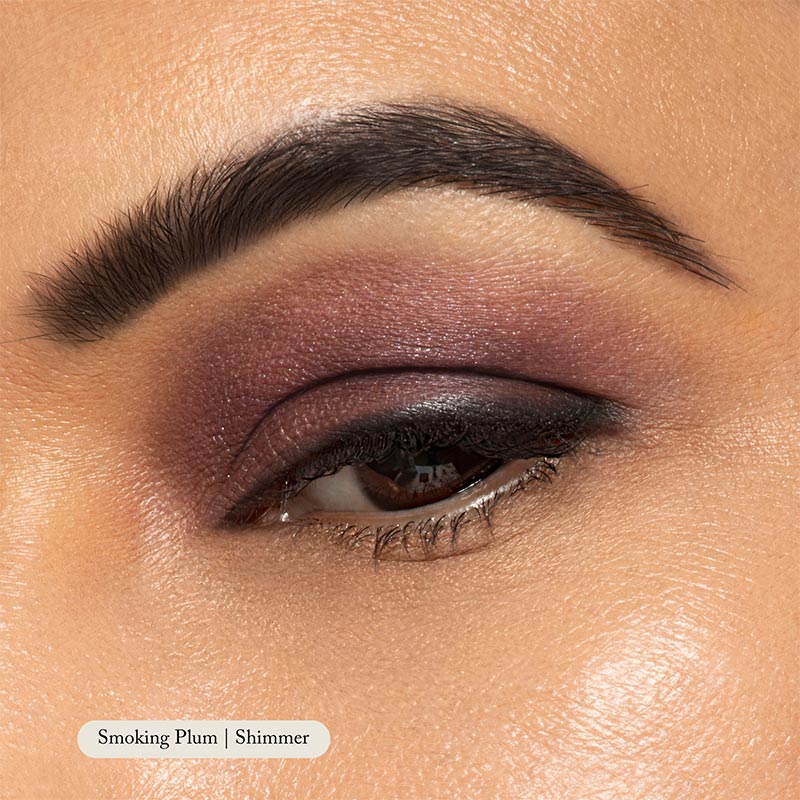If you want more compliments on your eye makeup but don’t have the artistic skills for complicated eyeliner, try eyeshadow. It’s appropriate for all skill levels, and all you need to do is find the right eyeshadow palette for your eye color.
Smokey eye, soft glam, champagne, and graphic eyeliner. No matter the makeup trend, the eyes are historically the most difficult to master.
But with the right tools and knowledge, you actually don’t need professional skills to enhance your natural eye color. Enter: eyeshadow. It’s easy to apply, adds an impactful pop of color, and is super forgiving if you make a mistake. To begin using eyeshadow, all you need to do is find the right color combos and leave an extra five minutes in your morning routine.

The Best Eyeshadow Colors for Brown Eyes
Consider purple, blue, brown, gold, and pink eyeshadow.
Brown is the most common eye color and the most difficult to color match. This is because shades of brown range from hazel to almost black. The best eyeshadow for brown eyes depends on your skin tone and seasonal color palette. Notice which colors look best on your complexion (particularly, browns) and experiment with those eyeshadow shades.
-
Purple and blue. These cooler tones make brown eyes stand out. Try periwinkle, teal, mauve, and lavender.
-
Warm jewel tones. Brown eyes give the perfect excuse to wear vibrant eyeshadow. Choose bright emerald, sapphire, ruby, and amethyst colors, especially with glitter.
-
Brown and gold. If you’re going for “big brown eyes,” gold or brown eyeshadow might be the best option. You can use just one brown or layer it with various shades. To enhance the effect, finish with a natural eyeliner.
-
Orange and pink. These bright summery tones make brown eyes pop, and they pair well with floral patterns.
The Best Eyeshadow Colors for Blue Eyes
To make your blue eyes pop, look for colors with warm undertones. These are typically yellow, orange, and maroon hues, but you can try natural shades like rose gold and brown, too.
-
Bronze and brown. For these more natural shades, look for bronze and brown with warm undertones and hints of orange, red, and yellow.
-
Yellow and rose gold. Yellow and blue are opposite on the color wheel, so yellow is one of the best eyeshadow colors for blue eyes. If you want a more natural look, use rose gold.
-
Grey and black. Just because your eyes are blue doesn’t mean you have to use extravagant colors to enhance them. Warm grey tones and blacks make an impressive smokey eye.
-
Maroon, green, and orange. These bright colors contrast blue eyes well and are fun for a layered eyeshadow look.
The Best Eyeshadow Colors for Green Eyes
Since green eyes are the rarest eye color, you may find it challenging to find the perfect eyeshadow match. A good rule of thumb is to use the same colors suitable for blue eyes but slightly lighter and brighter. Aim for red, yellow, and green undertones, even if you use natural shades of brown.
-
Pink and purple. Especially with red or burgundy undertones, these bright colors accentuate green eyes well.
-
Red and burgundy. Red is the opposite of green on the color wheel, so it’s the best color to contrast green eyes. For a casual lunch date or everyday look, choose softer reds like burgundy or mauve.
-
Deep grey. Not quite black, a light grey or charcoal grey can complement green eyes well. Use this for your everyday eye makeup or combine it with other neutral shades for date night makeup.
-
Bronze and neutral brown. Just like with blue eyes, you can wear natural color tones that complement your eye color. Just make sure these browns, blacks, and greys have red, yellow, or orange undertones (like with bronze).
Eyeshadow Application Tips
-
Use your lightest color as a transition shade
It’s best to start with the lightest color in your palette and then layer with darker colors. A transition shade hides blunt lines and makes the color of your natural skin tone blend seamlessly into the eyeshadow. You can use this color above your crease and up to the brow bone.
-
High-quality blending brushes matter
They really do. With almost any other makeup product, you can get away with a low-quality brush, your hands, or a beauty blender for application. But with eyeshadow, these methods make the color appear patchy. Choose a high-quality eyeshadow brush and apply gently.
-
Don’t skip the lower lash line
Adding a pop of color to your lower lash line completes the look and makes your eyeshadow stand out. Use your most prominent color and start at the outer corner of your eye, blending to about the halfway mark. You’ll want to make a seamless “V” shape that transitions from your upper eyelid to your lower eyelid.
-
Prep the eyelids
Even if you’re doing a simple two-step eyeshadow look, the right prep makes all the difference. Your eyelids are sensitive and can easily crease makeup, especially if you have hooded eyes. To create an even palette for makeup, start with a makeup primer. Apply this to your eyelids, then go in with a concealer. To create an extra-smooth finish, use a setting powder (like our mineral makeup) before applying your first color.
With Eyeshadow, Learn the Rules So You Can Break Them
Color theory proves that your eyeshadow palette matters. That said, makeup is an artistic skill. Your goal doesn’t always have to be the perfect color contrast. Sometimes it’s simply to have fun and create a look you’re proud of. Once you’ve mastered your unique eyeshadow palette, start experimenting with colors and shades you enjoy using, and see what your imagination comes up with.
Create Your Own Natural Eyeshadow Palette

